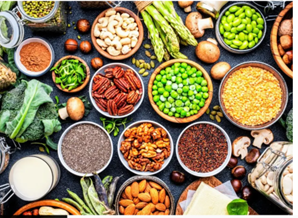
Eating more plant protein lowers the risk of heart disease: New research
In a 30-year study of American adults published in The American Journal of Clinical Nutrition (Glenn et al., 2024), “researchers found that individuals who consumed the highest ratio of plant-based protein to animal-based protein had a 19% lower risk of cardiovascular disease (CVD) and a 27% lower risk of coronary heart disease (CHD) compared to those with the lowest ratio. The findings suggest that a plant-to-animal protein ratio of at least 1:2 is effective in preventing CVD, while an even higher ratio of 1:1.3 may be necessary to protect against CHD.†(Ionescu, 2024; Glenn et al., 2024)
Plant protein and heart health
“The research is the first of its kind to investigate how the specific ratio of plant to animal protein impacts heart health.

Study lead author Andrea Glenn conducted the research as a postdoctoral fellow at Harvard T.H. Chan School of Public Health and is now an assistant professor at New York University.
“The average American eats a 1:3 plant to animal protein ratio. Our findings suggest a ratio of at least 1:2 is much more effective in preventing CVD. For CHD prevention, a ratio of 1:1.3 or higher should come from plants,†said Glenn.†(Ionescu, 2024; Glenn et al., 2024)
Three decades of data
“The researchers analyzed 30 years of dietary, lifestyle, and heart health data from nearly 203,000 men and women enrolled in the Nurses’ Health Studies I and II and the Health Professionals’ Follow-up Study.
Participants reported their dietary intake every four years. The team calculated each participant’s total daily protein intake in grams, as well as their specific consumption of animal and plant proteins.
During the study period, there were 16,118 documented cases of CVD, including over 10,000 CHD cases and more than 6,000 stroke cases.†(Ionescu, 2024; Glenn et al., 2024)
Risk reduction with plant proteins
After adjusting for participants’ health history, demographic, and lifestyle factors, the study found that a higher ratio of plant to animal protein was associated with lower risks of CVD and CHD.
Compared to those who consumed the lowest plant-to-animal protein ratio (~1:4.2), individuals with the highest ratio (~1:1.3) experienced a 19% reduction in CVD risk and a 27% reduction in CHD risk.
These benefits were even greater among participants who consumed more protein overall. Those who obtained 21% of their energy from protein and maintained a higher plant-to-animal protein ratio saw a 28% lower risk of CVD and a 36% lower risk of CHD, compared to those consuming 16% of their energy from protein.†(Ionescu, 2024; Glenn et al., 2024)
Substituting meat with plant-based sources
“No significant associations were found between stroke risk and the protein ratio; however, substituting red and processed meats with plant-based sources like nuts was linked to a reduced risk of stroke.
The researchers explored whether there is a point where increasing plant protein intake no longer provides additional benefits or could have negative effects.
They found that the risk reduction for CVD begins to level off around a 1:2 ratio of plant to animal protein, but the risk of CHD continues to decrease at higher ratios.†(Ionescu, 2024; Glenn et al., 2024)
Dietary changes for heart health
“According to the researchers, these risk reductions are likely due to replacing red and processed meats with plant protein sources, especially nuts and legumes.â€


“Such dietary changes have been shown to improve cardiometabolic risk factors like blood lipid levels, blood pressure, and inflammatory biomarkers. Plant proteins are often rich in fiber, antioxidant vitamins, minerals, and healthy fats, which contribute to these benefits.â€
“Most of us need to begin shifting our diets toward plant-based proteins,†said senior author Frank Hu, Fredrick J. Stare Professor of Nutrition and Epidemiology at Harvard Chan School.
“We can do so by cutting down on meat, especially red and processed meats, and eating more legumes and nuts. Such a dietary pattern is beneficial not just for human health but also the health of our planet.â€
“The researchers emphasized that the ratios identified are estimates, and additional studies are necessary to determine the optimal balance between plant and animal protein. Further research is also needed to understand how protein intake may affect stroke risk.†(Ionescu, 2024; Glenn et al., 2024)
References
Ionescu A. Eating more plant protein lowers risk of heart disease. Earth.com. December 3, 2024. Available at: https://www.earth.com/news/eating-more-plant-protein-lowers-the-risk-of-heart-disease/
Glenn AJ, Wang F, Tessier AJ, Manson JE, Rimm EB, Mukamal KJ, Sun Q, Willett WC, Rexrode KM, Jenkins DJ, Hu FB. Dietary plant-to-animal protein ratio and risk of cardiovascular disease in 3 prospective cohorts. The American Journal of Clinical Nutrition. 2024;120(6): 1373-1386
